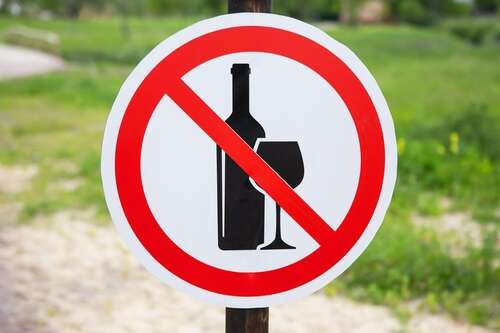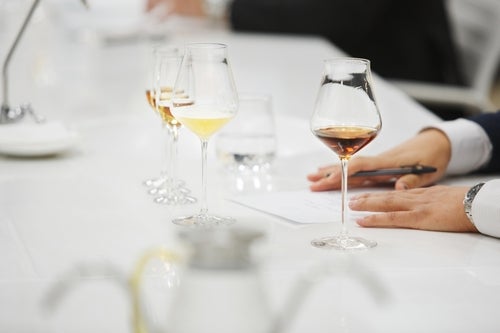
Dr Erik Skovenborg takes a skeptical look at the science behind the World Health Organization’s warning that there is “no safe level” of alcohol consumption.
A national survey in France in 1954 showed that the French, as a nation, regarded a daily intake of nearly 2 liters (approx 2 quarts) of wine as not being harmful either to the body or to the mind of a working man.1 By contrast, in a news release in January 2023, the World Health Organization warned that “No level of alcohol consumption is safe for our health.”2 “We cannot talk about a so-called safe level of alcohol use. It doesn’t matter how much you drink—the risk to the drinker’s health starts from the first drop of any alcoholic beverage,” Dr Carina Ferreira-Borges wrote. “The only thing that we can say for sure is that the more you drink, the more harmful it is—or, in other words, the less you drink, the safer it is.” The “no safe level” dogma is bad news indeed for today’s wine drinkers who appreciate a glass or two with their meal and who consider themselves to be sensible drinkers. Should the many people who derive pleasure from a glass of wine become abstainers? Or is the absolute risk of light or moderate drinking so small that it is perfectly reasonable to decide that the quality of life gained from enjoyment of wine is greater than the potential harms it entails?
No safe level: Solid evidence or weak associations?
“Alcohol is a toxic, psychoactive, and dependence-producing substance and has been classified as a Group 1 carcinogen by the International Agency for Research on Cancer decades ago—this is the highest risk group, which also includes asbestos, radiation and tobacco.”2 As a matter of fact, however, group 1 carcinogens are not “the highest-risk group” but a group of substances where there is enough evidence to conclude that they can cause cancer in humans. The list of group 1 carcinogens also includes, for example, processed meat, salted fish, wood dust, and ambient air pollution.
“Alcohol causes at least seven types of cancer, including the most common cancer types, such as bowel cancer and female breast cancer. The risk of developing cancer increases substantially the more alcohol is consumed. However, latest available data indicate that half of all alcohol-attributable cancers in the WHO European Region are caused by ‘light’ and ‘moderate’ alcohol consumption—less than 1.5 liters of wine or less than 3.5 liters of beer or less than 450 milliliters of spirits per week.”2 Rovira & Rehm found, however, that light to moderate drinking levels of alcohol (<20g alcohol/day) accounted for 2.3% of all cases of the seven alcohol-related cancer types. Almost half of these cases were female breast cancers. More than one third of the cancer cases due to light to moderate drinking resulted from a light drinking level of <1 standard drink per day.3
Conversely, a recent meta-analysis found that drinking up to 15g alcohol per day is not associated with the incidence of the 20 most common cancer types in the Western world, in contrast to higher consumption. It was noteworthy that the association with light and moderate alcohol consumption was negative for cancers such as (non)-Hodgkin lymphoma, leukemia, and lung and renal cancer.4
Serious methodological issues: heterogeneity
A positive association between alcoholic-beverage consumption and risk of several types of cancer is supported by more than 100 epidemiological studies. The evidence base, however, shares a number of methodological issues—such as study heterogeneity, the understudied role of different drinking patterns, and underreporting of various magnitude. Study heterogeneity delineates the variability in study outcomes that goes beyond what could be explained due to chance or measurement error. Differences between results of studies may be so high that calculation of an average effect size in a meta-analysis would make too little sense.5
A brand-new evidence synthesis of 122 systematic reviews and meta-analyses of causes and risk factors of breast cancer—“What Do We know for Sure?”—found that many of the included studies investigating the same topics had confusing or conflicting results. Three systematic reviews of alcohol use and breast cancer were included in this evidence synthesis with inconsistent findings. The conclusions varied from “there is an association” between alcohol consumption and breast cancer risk, to “the association remains insufficient”; from “high intake of wine contributes” to breast cancer risk, to “protection is exerted with low doses of wine.” Although one of these meta-analyses concluded with an association with an effect size of 1.28, the result did not qualify for the “top list” of important findings because of high heterogeneity.6
Patterns of alcohol consumption
The volumes of alcohol intake listed as “light or moderate consumption” does not represent a drinking pattern but is a categorization of drinking level by quantity. Most studies categorize light alcohol consumption as ≤ 1 drink (10g)/day, but the “10g/day category” is an artifact produced by converting consumption data (for example, alcohol intake per week) into daily averages. Unfortunately, very few cohort studies have information about drinking patterns, so it is not known whether a consumption of, say, 70g alcohol per week is consumed as one drink per day spread over six or seven days, or as binge drinking on weekends. There is no empirical justification for the practice of converting consumption data into daily averages, and study results suggest that the harm associated with relatively low weekly volumes of consumption may be largely attributable to the contribution of just a few heavy drinking days.7
“Patterns of alcohol consumption are hypothesized to modify the risk relationship between alcohol consumption and breast cancer,” Shield et al wrote in a review of alcohol and breast cancer.8 “However, only a few drinking-pattern studies exist, and epidemiological evidence on this effect modification is limited and inconsistent.” Shield et al presented six studies in the review, but three other published studies were not noticed by the authors, and since then, four new studies with data on drinking pattern and cancer risk have been published. Overall, the findings provide evidence for an increased risk associated with heavy episodic drinking, especially among moderate lifetime drinkers. For example, Ma et al defined a healthy drinking habit score (DHS) by regular drinking (frequency of alcohol intake ≥ three times per week) and by consuming alcohol with meals.9 One point was given for each favorable drinking habit (range of 0–2). After adjustment for potential confounders and amount of alcohol consumed, regular drinking was associated with an 8% lower risk of cancer mortality as compared with non-regular drinking. Compared with participants who consumed alcohol outside meals and those who had varying patterns, participants who consumed alcohol with meals had a 10% lower risk of cancer mortality. A positive linear association of alcohol intake and cancer mortality was observed in participants with an unfavorable DHS, whereas a U-shaped association was observed in participants with favorable DHS. A moderate alcohol intake (50–200g per week) was not associated with cancer mortality in participants with a favorable DHS.
Underreporting of alcohol intake
Self-reported information on alcohol consumption is known to underestimate true consumption. Systematic underreporting of consumption by both cases and controls would result in an overestimation of the relative risk of breast cancer for a given level of alcohol consumption. Moreover, the shape of the dose-response relationship could be changed if heavy drinkers were more likely to underreport intake than moderate drinkers. Taken together, these reporting errors imply that some uncertainty remains about the true quantitative effect of an intake of a fixed amount of alcohol on the risk of developing cancer. In a cohort study of cancer risk in participants reporting light to moderate drinking, the increased risk of cancer was concentrated in the stratum suspected of underreporting.10
No safe level: Conclusion
Recommendations from the WHO and other health authorities use several uncertain consensus statements to guide us to a healthy lifestyle. The WHO warning of “no safe level of alcohol consumption” has an absurdity to it, and the evidence base for a significant association between light drinking (≤ 10g alcohol per day) and risk of cancer is fraught with weak associations and methodological issues. The WHO statement is more political than medical, and that’s a disservice to sensible, moderate wine drinkers.
A thoroughly researched volume to square up to the neo-temperance lobby
Drinking with friends: Wine’s role as a social lubricant
NOTES
1. H Bastide, Population 9 (1954), p.13.
2. who.int/europe/news/item/04-01-2023-no-level-of-alcohol-consumption-is-safe-for-our-health
3. P Rovira and J Rehm, “Estimation of Cancers Caused by Light to Moderate Alcohol Consumption in the European Union,” European Journal of Public Health 31 (2021), pp.591–96.
4. H Hendriks and W Calame, “The Contribution of Alcohol Consumption to Overall Cancer Incidence in the Western World: A meta-analysis,” Journal of Nutritional Health Science 5 (2018), p.308.
5. JP Higgins, SG Thompson, JJ Deeks, DG Altman, “Measuring Inconsistency in Meta-Analyses,” British Medical Journal 327 (2003), pp.557–60.
6. B Løyland, IH Sandbekken, EK Grov, I Utne, “Causes and Risk Factors of Breast Cancer—What Do We Know for Sure? An Evidence Synthesis of Systematic Reviews and Meta-Analyses,” Cancers 16 (2024), p.1583.
7. G Knupfer, “Drinking for Health: The daily light drinker fiction,” British Journal of Addiction 82 (1987), pp.547–55.
8. KD Shield, I Soerjomataram, J Rehm, “Alcohol Use and Breast Cancer: A critical review,” Alcohol: Clinical Experimental Research 40 (2016), pp.1166–81.
9. H Ma, X Li, T Zhou, D Sun, I Shai, Y Heianza, et al, “Alcohol Consumption Levels as Compared with Drinking Habits in Predicting All-Cause Mortality and Cause-Specific Mortality in Current Drinkers,” Mayo Clinic Proceedings 96 (2021), pp.1758–69.
10. AL Klatsky, N Udaltsova, Y Li, D Baer, et al, “Moderate Alcohol Intake and Cancer: The role of underreporting,” Cancer Causes Control 25 (2014), pp.693–99.






